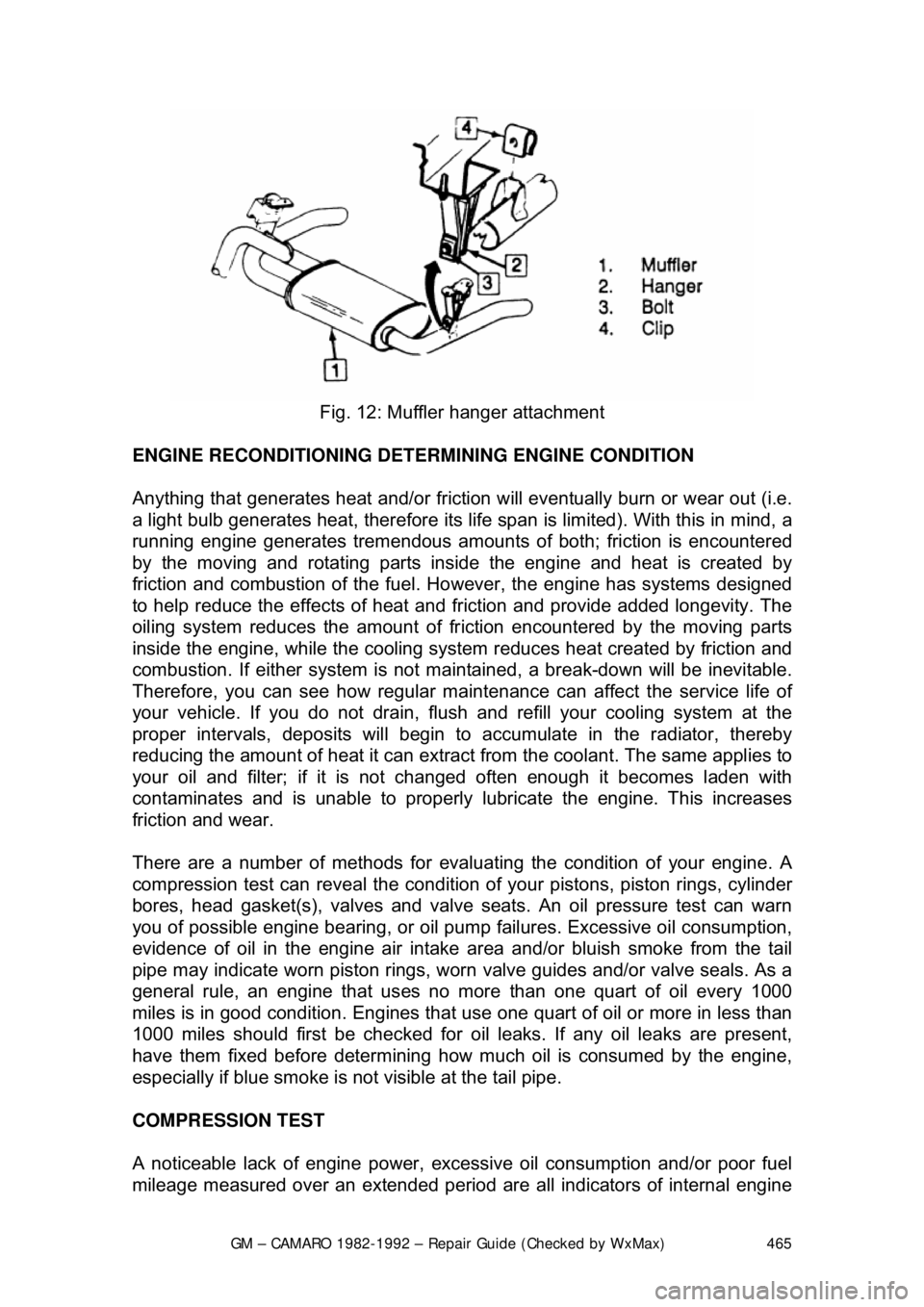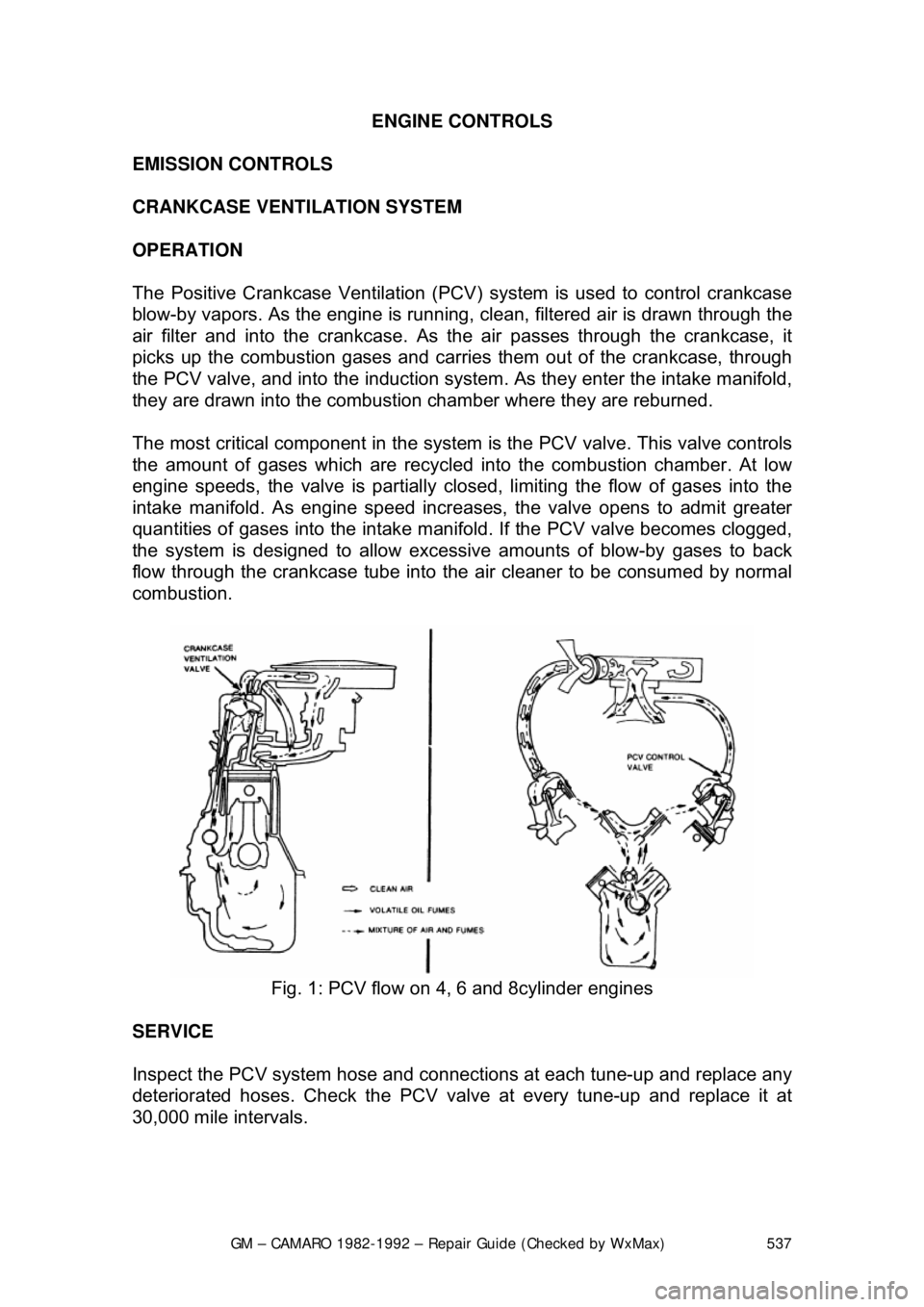service interval CHEVROLET CAMARO 1982 Repair Guide
[x] Cancel search | Manufacturer: CHEVROLET, Model Year: 1982, Model line: CAMARO, Model: CHEVROLET CAMARO 1982Pages: 875, PDF Size: 88.64 MB
Page 465 of 875

GM – CAMARO 1982-1992 – Repair Guide (Checked by WxMax) 465
Fig. 12: Muffler hanger attachment
ENGINE RECONDITIONING DETE RMINING ENGINE CONDITION
Anything that generates heat and/or friction will eventually burn or wear out (i.e.
a light bulb generates heat, therefore its life span is limited). With this in mind, a
running engine generates trem endous amounts of both; friction is encountered
by the moving and rotating parts inside the engine and heat is created b\
y
friction and combustion of the fuel. Ho wever, the engine has systems designed
to help reduce the effects of heat and fr iction and provide added longevity. The
oiling system reduces the amount of fr iction encountered by the moving parts
inside the engine, while the cooling system reduces heat created by friction and
combustion. If either system is not main tained, a break-down will be inevitable.
Therefore, you can see how regular main tenance can affect the service life of
your vehicle. If you do not drain, flush and refill your cooling system at the
proper intervals, deposits will begin to accumulate in the radiator, thereby
reducing the amount of heat it can extrac t from the coolant. The same applies to
your oil and filter; if it is not changed often enoug h it becomes laden with
contaminates and is unable to properly lubricate the engine. This increases
friction and wear.
There are a number of methods for evaluat ing the condition of your engine. A
compression test can reveal the condition of your pistons, piston rings, cylinder
bores, head gasket(s), valves and valve seat s. An oil pressure test can warn
you of possible engine bearing, or oil pump failures. Excessive oil consumption,
evidence of oil in the engine air intake area and/or bluish smoke from the tail
pipe may indicate worn piston rings, worn valve guides and/or valve seals. As a
general rule, an engine that uses no more than one quart of oil every 1000
miles is in good condi tion. Engines that use one quart of oil or more in less than
1000 miles should first be checked for oil leaks. If any oil leaks are present,
have them fixed before dete rmining how much oil is consumed by the engine,
especially if blue smoke is not visible at the tail pipe.
COMPRESSION TEST
A noticeable lack of engine power, excessive oil consumption and/or poor fuel
mileage measured over an extended period are all indicators of internal engine
Page 537 of 875

GM – CAMARO 1982-1992 – Repair Guide (Checked by WxMax) 537
ENGINE CONTROLS
EMISSION CONTROLS
CRANKCASE VENTILATION SYSTEM
OPERATION
The Positive Crankcase Ventilation (PCV ) system is used to control crankcase
blow-by vapors. As the engine is running, clean, filtered air is drawn through the
air filter and into the crankcase. As the air passes through the crankca\
se, it
picks up the combustion gases and carries them out of the crankcase, through
the PCV valve, and into the induction system . As they enter the intake manifold,
they are drawn into the combustion chamber where they are reburned.
The most critical component in the system is the PCV valve. This valve controls
the amount of gases which are recycled into the combustion chamber. At low
engine speeds, the valve is partially clos ed, limiting the flow of gases into the
intake manifold. As engine speed incr eases, the valve opens to admit greater
quantities of gases into the intake manifold. If the PCV valve becomes clogged,
the system is designed to allow excessive amounts of blow-by gases to back
flow through the crankcase tube into the air cleaner to be consumed by normal
combustion.
Fig. 1: PCV flow on 4, 6 and 8cylinder engines
SERVICE
Inspect the PCV system hose and connecti ons at each tune-up and replace any
deteriorated hoses. Check the PCV valve at every tune-up and replace it at
30,000 mile intervals.